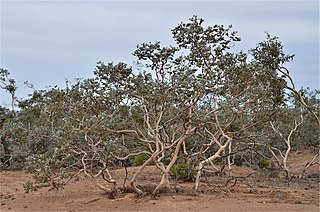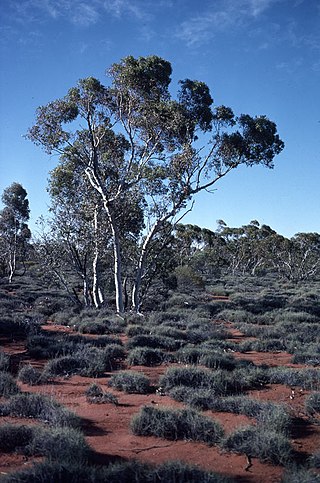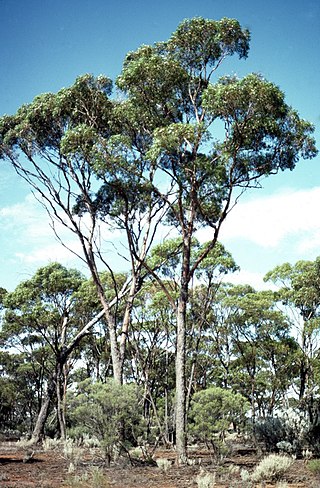
Eucalyptus morrisbyi, commonly known as Morrisby's gum, is a species of small to medium-sized tree that is endemic to a restricted area of Tasmania. It has loose slabs of rough bark near the base of its trunk, smooth pale grey bark above, lance-shaped to egg-shaped adult leaves, flower buds in groups of three, white flowers and barrel-shaped or cylindrical fruit. It is only known in the wild from a few small populations but has been widely planted as an ornamental.

Eucalyptus radiata, commonly known as the narrow-leaved peppermint or Forth River peppermint, is a species of tree that is endemic to south-eastern Australia. It has rough, fibrous to flaky bark on the trunk and larger branches, smooth grey bark on the thinner branches, lance-shaped to curved or almost linear leaves, flower buds in groups of eleven to twenty or more, white flowers and cup-shaped, hemispherical or shortened spherical fruit.

Eucalyptus cinerea, commonly known as the Argyle apple, mealy stringbark or silver dollar tree, is a species of small- to medium-sized tree that is endemic to south-eastern Australia. It has rough, fibrous bark on the trunk and branches, usually only juvenile, glaucous, egg-shaped evergreen leaves, flower buds in groups of three, white flowers and conical to bell-shaped fruit.

Eucalyptus tricarpa, commonly known as red ironbark or mugga ironbark, is a species of tree that is endemic to south-eastern Australia. It has thick, rough ironbark on the trunk and branches, lance-shaped adult leaves, flower buds usually in groups of three, white flowers and cylindrical or spherical fruit.

Eucalyptus globulus subsp. bicostata, commonly known as the southern blue gum, eurabbie, blue gum or Victorian blue gum, is a subspecies of tree that is endemic to south-eastern Australia. It has mostly smooth bark with some persistent slabs of old bark at the base, juvenile leaves with one glaucous side, glossy, lance-shaped adult leaves, warty flower buds in groups of three, white flowers and hemispherical to conical fruit.

Eucalyptus sieberi, commonly known as the silvertop ash or black ash, is a species of medium-sized to tall tree that is endemic to south-eastern Australia. It has rough bark on the trunk and the base of larger branches, and smooth bark above. It has lance-shaped to curved adult leaves and flower buds in groups of seven to fifteen, which bear white flowers and barrel-shaped or conical fruit.

Eucalyptus kartzoffiana, commonly known as the Araluen gum, is a species of medium-sized tree that is endemic to a small area of southeastern New South Wales. It has rough, fibrous or flaky bark on part or most of its trunk, lance-shaped or curved adult leaves, flower buds in groups of three, white flowers and sessile, bell-shaped fruit.

Eucalyptus gillii, known as the curly mallee, Arkaroola mallee, or silver mallee, is a species of mallee or small tree that is endemic to inland Australia. It has smooth bark, sometimes with rough bark near the base, often only juvenile, usually glaucous leaves in the crown, flower buds in groups of between seven and eleven, pale yellow flowers and barrel-shaped or shortened spherical fruit.

Eucalyptus porosa, commonly known as mallee box, Quorn mallee or water mallee, is a species of mallee or a tree that is endemic to southern Australia. It has rough, fibrous or flaky bark on the trunk and larger branches, smooth greyish bark above, lance-shaped adult leaves, flower buds in groups of seven, white flowers and barrel-shaped or shortened spherical fruit.

Eucalyptus intertexta, commonly known as inland red box, western red box, gum coolibah or the bastard coolibah, is a species of tree that is endemic to central Australia. It has rough, fibrous or flaky bark on the base of the trunk, smooth white to brownish bark above, lance-shaped adult leaves, flower buds in groups of seven on the ends of branchlets, white flowers and cup-shaped to hemispherical fruit.

Eucalyptus nortonii, commonly known as bundy, mealy bundy or long-leaved box, is a species of small tree that is endemic to south-eastern Australia. It has rough, thick, fibrous or flaky bark on the trunk and larger branches, smooth greyish bark on the thinnest branches, lance-shaped to curved adult leaves, flower buds in groups of seven, white flowers and cup-shaped or cylindrical fruit.

Eucalyptus paliformis, commonly known as Wadbilliga ash, is a species of small to medium-sized tree that is endemic to a small area in southern New South Wales. It has smooth bark, lance-shaped to curved adult leaves, flower buds in groups of seven, white flowers and shortened spherical fruit.

Eucalyptus staeri, commonly known as Albany blackbutt, is a species of small tree or a mallee and is endemic to the south-west corner of Western Australia. It has rough bark on the trunk and branches, thick, lance-shaped adult leaves, flowers buds in groups of between seven and fifteen, creamy white flowers and shortened spherical fruit.

Eucalyptus gongylocarpa, commonly known as baarla, marble gum or desert gum, is a species of tree endemic to central Australia. It has smooth bark, lance-shaped to elliptical leaves arranged more or less in opposite pairs, flower buds in groups of seven, whitish flowers and more or less spherical fruit.

Eucalyptus longicornis, commonly known as red morrel, morryl, poot or pu, is a species of large tree that is endemic to the south-west of Western Australia. It has rough, fibrous, fissured bark on the trunk, smooth greyish bark above, flower buds in groups of seven or more, white flowers and shortened spherical fruit.
Eucalyptus remota, commonly known as the Kangaroo Island ash, Kangaroo Island mallee ash, or Mount Taylor mallee, is a species of tree or mallee that is endemic to Kangaroo Island in South Australia. It has smooth bark, often with rough, fibrous bark on the trunk, lance-shaped adult leaves, flower buds in group of between nine and twenty one, white flowers and hemispherical or shortened spherical fruit.

Eucalyptus corrugata, also known as rough fruited mallee or rib-fruited mallee, is a species of tree or mallee that is endemic to Western Australia. It has rough scaly or fibrous bark on the lower part of its trunk, smooth bark above, glossy, lance-shaped adult leaves, prominently corrugated flower buds arranged in groups of three in leaf axils and ribbed, conical to cup-shaped fruit.

Eucalyptus microneura, commonly known as Gilbert River box, is a species of small to medium-sized tree that is endemic to Queensland. It has rough, fibrous or flaky bark on the trunk and branches, lance-shaped adult leaves, flowers in groups of seven on a branching peduncle, white flowers and conical fruit.

Eucalyptus sphaerocarpa, commonly known as the Blackdown stringybark, is a species of tall forest tree that is endemic to Queensland. It has rough, stringy bark on the trunk and branches, lance-shaped to curved adult leaves, flower buds in groups of seven, nine or eleven, white flowers and shortened spherical fruit.
Eucalyptus tephrodes is a species of small tree or mallee that is endemic to Western Australia. It has rough bark on the trunk and larger branches, smooth bark above, egg-shaped to lance-shaped adult leaves, flower buds in groups of three on the ends of branchlets and cup-shaped to hemispherical fruit.






















